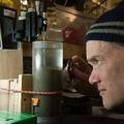Article
Investigating the Effect of Bioirrigation on In Situ Porewater Concentrations and Fluxes of Polychlorinated Biphenyls Using Passive Samplers
Environmental Science & Technology
(2018)
Abstract
Polychlorinated biphenyl (PCB) fluxes from contaminated sediments can be caused by mechanisms including diffusion, bioirrigation, and resuspension, but it is often unclear which mechanisms are important. In the Lower Duwamish Waterway (Seattle, Washington), the presence of abundant benthic macrofauna suggests that porewater bioirrigation may be an important mechanism for PCB transport from the bed into the overlying water column. In this field study, the fluxes of PCBs due to bioirrigation were quantified by using (a) polyethylene (PE) samplers to quantify in situ and ex situ (i.e., equilibrium) PCB porewater concentration profiles and (b) measurements of the geochemical tracer 222Rn to quantify the rate of porewater exchange with overlying water. The results showed that bioirrigation caused sorptive disequilibrium with the surrounding sediment, which led to lower in situ porewater concentrations than expected from sediment concentrations. The combined fluxes of seven PCB congeners (Σ7PCBs) were 1.6–26 ng/m2/day for the three field sites, similar in magnitude to the upper limit estimates of diffusive fluxes calculated assuming water-side boundary layer control (Σ7PCBs = 1.3–47 ng/m2/day). Moreover, the depleted in situ porewater concentrations imply lower diffusive flux estimates than if the ex situ porewater concentrations had been used to estimate fluxes (Σ7PCBs = 89–670 ng/m2/day). These results suggest that nondiffusive PCB fluxes from the sediment bed are occurring and that quantifying in situ porewater concentrations is crucial for accurately quantifying both diffusive and nondiffusive PCB fluxes.
Keywords
- Bioirrigation,
- HOC contamination,
- Hydrophobic organic compounds
Disciplines
Publication Date
2018
DOI
10.1021/acs.est.7b05809
Citation Information
Investigating the Effect of Bioirrigation on In Situ Porewater Concentrations and Fluxes of Polychlorinated Biphenyls Using Passive Samplers. Jennifer N. Apell, David H. Shull, Alison M. Hoyt, and Philip M. Gschwend Environmental Science & Technology 2018 52 (8), 4565-4573
DOI: 10.1021/acs.est.7b05809
